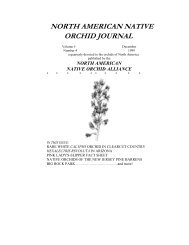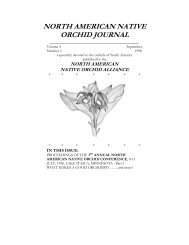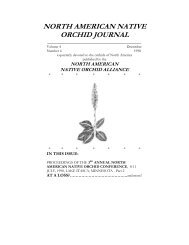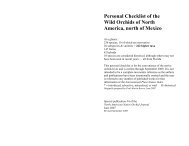north american native orchid journal - at The Culture Sheet
north american native orchid journal - at The Culture Sheet
north american native orchid journal - at The Culture Sheet
You also want an ePaper? Increase the reach of your titles
YUMPU automatically turns print PDFs into web optimized ePapers that Google loves.
Folsom: A CASE FOR EVOLUTION<br />
the mechanisms and str<strong>at</strong>egies th<strong>at</strong> North American <strong>orchid</strong>s have<br />
developed to cope with these events th<strong>at</strong> have changed their<br />
world.<br />
Let us examine the polliniz<strong>at</strong>ion processes th<strong>at</strong> <strong>orchid</strong>s<br />
have devised to ensure their survival. This process has evolved to<br />
be very specific in many <strong>orchid</strong> species. <strong>The</strong>y have unique<br />
techniques and <strong>at</strong>tract only certain agents of pollin<strong>at</strong>ion.<br />
As everyone knows <strong>orchid</strong>s have 3 sepals and 3 petals with<br />
the stamen(s) and pistil fused into a column. <strong>The</strong> three petals<br />
consist of two l<strong>at</strong>eral petals and the third petal is formed into a lip.<br />
<strong>The</strong> lip acts as both an <strong>at</strong>tractant and landing pl<strong>at</strong>form for many<br />
pollin<strong>at</strong>ors. <strong>The</strong> many genera and species of <strong>orchid</strong>s have lips in<br />
varying size, shape, and colors th<strong>at</strong> entice many kinds of<br />
pollin<strong>at</strong>ors including butterflies, moths, bees, wasps, flies, and<br />
gn<strong>at</strong>s, to name a few. Some <strong>orchid</strong>s use scent, often <strong>at</strong> a specific<br />
time of day or night, to <strong>at</strong>tract the pollin<strong>at</strong>ors, others brilliant<br />
color, and still others dynamic p<strong>at</strong>terns. Many botanists have<br />
w<strong>at</strong>ched <strong>orchid</strong>s hoping to discover the actual pollin<strong>at</strong>ors or kinds<br />
of actions th<strong>at</strong> were required to ensure fertiliz<strong>at</strong>ion. Roger<br />
Hammer, of Homestead, Florida, spent several nights in the<br />
Fakah<strong>at</strong>chee Swamp to observe the giant nocturnal moth th<strong>at</strong><br />
pollin<strong>at</strong>es the ghost <strong>orchid</strong>, Dendrophylax lindenii (Hammer, 1996).<br />
Calopogons are constructed in<br />
such a way th<strong>at</strong> their lip is<br />
uppermost. With the lip in this<br />
position when the heavy bee<br />
pollin<strong>at</strong>or <strong>at</strong>taches itself to the<br />
<strong>at</strong>tractive yellow beard (a false<br />
pollen) it snaps down with the bee’s<br />
weight and deposits the pollen<br />
brought from the bee’s visit to<br />
another blossom into contact with<br />
the flower’s stigm<strong>at</strong>ic surface, therefore effecting pollin<strong>at</strong>ion.<br />
Some species even allow rain, by assisting the transfer of the<br />
pollen, to act as the agent for pollin<strong>at</strong>ion (C<strong>at</strong>ling, 1980).<br />
45













